Google Fi: Their new $20/month Worldwide Phone Service
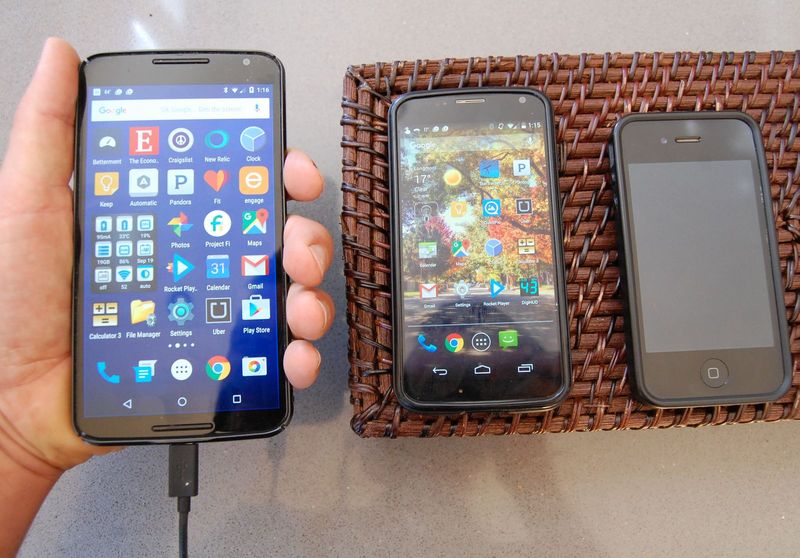

Shot on Nexus 6 - you may start noticing nicer pictures on this blog from now on.
If you've been around here for a while, you know that I have been a fan of Republic Wireless for several years now. Sneaking onto the scene in 2012, they quietly started offering a more-or-less Unlimited Everything smartphone plan for $19 per month while most of us were still forking over $50 to $100 for our service.
I joined their beta program as soon as they would let me in and I've been a happy customer ever since. I wrote about it more than once and thousands of this blog's readers have become loyal customers since then. It's almost a badge of membership, to whip out your Republic Moto X phone at a meetup of Mustachians to show you are the real deal.
Since then, the company has been upgrading technology, bringing in new phones and recently changed their plan structure to become even cheaper for the majority of users: $10 per month base price (unlimited talk and text) / with data as needed at $1.50 per 100 megabytes with no minimum charge (see Figure 1 for an example).
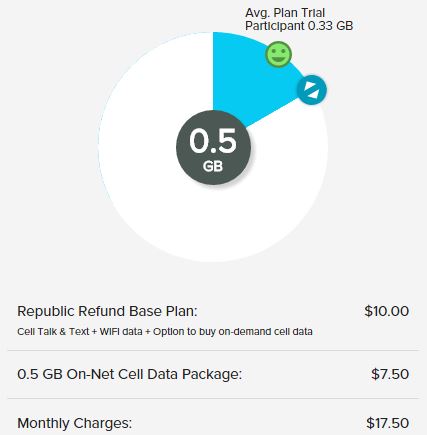
Fig. 1: Republic's rate structure as of September 2015
Despite the boiling competition in the US phone market (among dozens of companies known as Mobile Network Virtual Operators), the Republic setup has been a no-brainer and no other offer has tempted me to stray from my simple plan.
Until Now.
This year, rumors started circulating that Google itself was starting a phone service called Google Fi. I'm a long-time Google Fanboy and I get great life efficiency gains from their search, email, calendar, documents, photo, and map/navigation programs among others. So I had high expectations.
Although the $20 per month base price was double that of Republic Wireless, I found the specs tantalizing because the Google Phone service works virtually worldwide with no roaming charges. That is right - in 120 countries, you get seamless voice, text and data at the same price as you do in the US:
Google Fi Pricing:
" $20 per month for unlimited talk+ text
" $10 per Gigabyte ($1 per 100MB) data In Most Developed areas of the Earth
" And it includes Wi-Fi Tethering
This sounded useful to me, since the Mustache family spends every summer in Canada, plus I end up in Central or South America at least once a year too. Longer stays in Europe, Australia and New Zealand are coming too, as my boy grows up and becomes more comfortable with the world outside our bubble. While my Republic service continues to work worldwide whenever there is Wi-fi, I have found the lack of true international cellular access to be quite limiting when planning complex adventures on the fly. When you add in tethering (the ability to broadcast my own private Internet Cafe) to allow me to work on the blog with a laptop in foreign lands or share data with friends, the appeal became even stronger.
At this point, you would be fully right to start playing your Mocking Violin of Consumer Justifications, then ask if I'd like a Bedpan and a Catheter to go along with this serving of Worldwide Data and Wi-fi tethering. It's totally over-the top, and if I were living my true retired pre-Mr. Money Mustache-life, I'd be traveling less, floating in fewer business expense account dollars, and probably not upgrading to Google Fi at this point. Especially when you find out how much the phone cost me.
The Overly Fancy Nexus 5x and 6P Phones
Like Republic Wireless, Google Fi keeps costs down (and flexibility up) by using a hybrid calling system: if you are out in the wild, the phone selects between Sprint, T-mobile, or international carrier networks as needed. But if you're connected to a reliable Wi-Fi network, it routes all your calls and text seamlessly through the Internet instead. You don't have to know what is going on in the background, but it means the phone needs some special capabilities and software to let this happen. This means that both Republic and Fi only work on selected phones.
When I first wrote this post in September 2015, Google Fi service was available on only one phone, a massive but powerful "phablet" called the Nexus 6. Now the phone options have greatly improved. As of December, Amazon has the best price (and service) if you're in the market for the 5x, but the Google store is $150 less on the 6P.
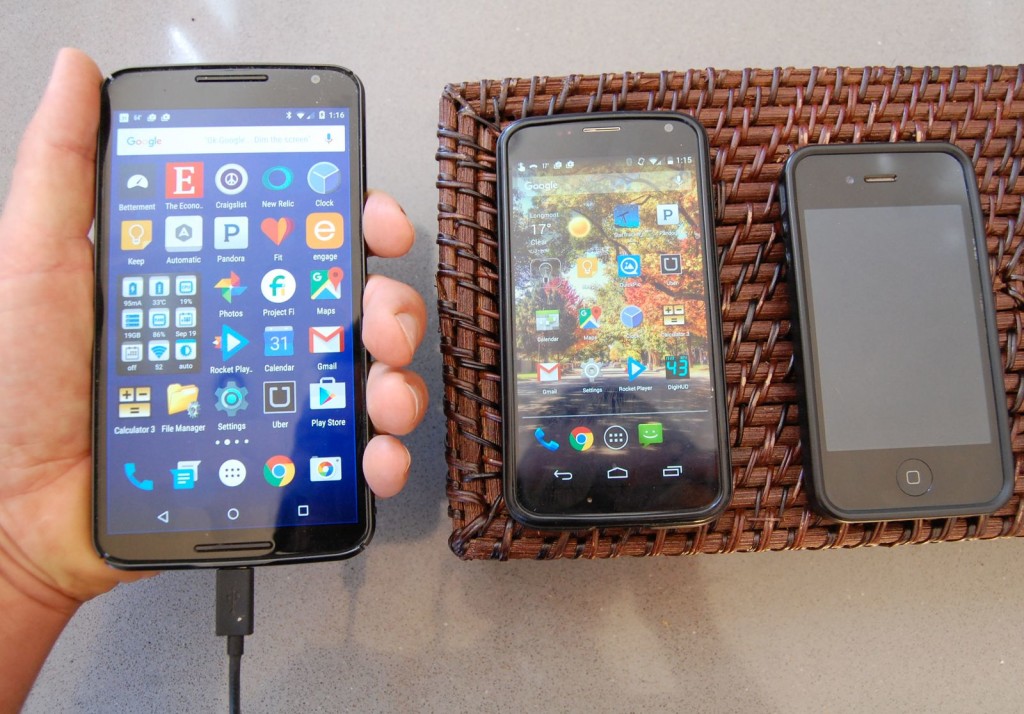
Nexus 6 vs. Moto X v1 vs. Antique iPhone 4 for scale, all with thin protective cases. All phones are equidistant from the camera, so the Nexus is indeed way bigger. But Look how many icons and fancy things I can fit on my homescreen now! Note that my hands are on the XL side, so it might be a two-hands phone for less lanky readers.
This was my biggest reservation about adopting the service back when the Nexus 6 was the only option, because I have some manly insecurities about public displays of technology. I like my phone functional, but minimalist and tough. My phone spends most of its days walking around in a tattered pair of construction pants experiencing heat, pressure and sawdust. In the winter it might be squeezed into some snowboard pants next to a Ziploc of almonds and sliced cheese. I drop it on concrete floors occasionally. I attempt to take selfie videos while mountain biking. And I try to take incognito photos of jam bands through the cloud of Marijuana smoke that hangs over the busy crowd of fellow revelers. None of these activities seem to pair nicely with a $350 telephone that sports a massive, bright 6"^3 screen with 2560i-1440 resolution. I was worried that cooler men would make fun of me if I whipped out a big toy like this in public.
But in real life, it's not so bad. My initial horror at the size of the phone upon opening the box quickly faded, and I noticed that it is definitely more useful for reading long emails, books and websites. The clarity and color of the screen is somewhat astonishing, as is the quality of photos and videos the camera can produce. It has stereo speakers that are actually good enough to get a few friends dancing in your hotel room in a pinch. It also has long life battery and a multi-mode charger that can fill the big battery much more quickly than normal, ideal for a rapid boost during a day of travel. It's powerful enough that I will now start leaving my laptop behind for most trips. And it still fits easily in my pocket.
With a few adjustments to daily life (I stash the phone in a backpack instead of my pocket when doing a harsh day of construction), it works fine for me after all. And for those with office jobs, it is even more compatible.
But How Much Will the Data Cost Me?
The first question I had when moving away from a plan with 'unlimited' data, is how much the new setup will cost in typical use. The easiest way to check was to look at my data use on the Republic plan during early August, which was a time of extensive travel for me. Both Google Fi and Republic make this really easy with their respective built-in apps:
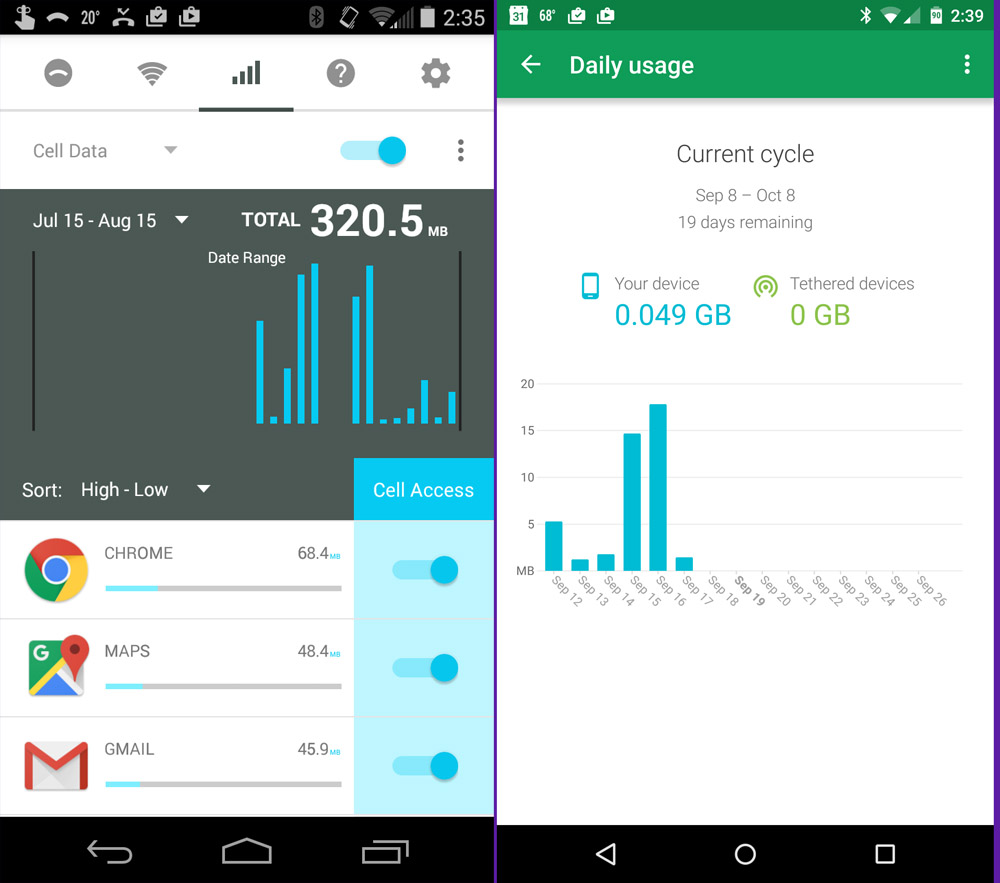
My Republic data use in August (left) vs. Google (right) data use over the past week. My peak month in the past year was about 320MB.
For those who use more, your optimum choice will vary because of the different rates of the two carriers.
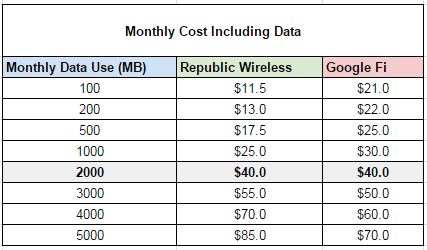
Due to Google's cheaper data rates, they break even with Republic around the 2GB/month data usage level.
How to Cut YourData Use
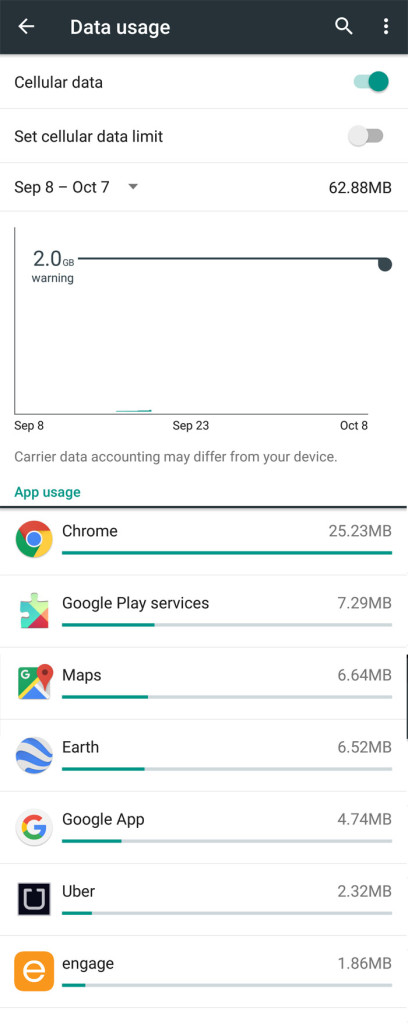 If you find you're using much more than me, it might be due to apps stealing some of your data in the background rather than stuff you're actually doing yourself. If you look at Settings -> Data Usage, you'll see a breakdown of how much data each application consumed. Then you can decide to nuke or restrict any apps that you don't think should be using data while the phone sits in your pocket.
If you find you're using much more than me, it might be due to apps stealing some of your data in the background rather than stuff you're actually doing yourself. If you look at Settings -> Data Usage, you'll see a breakdown of how much data each application consumed. Then you can decide to nuke or restrict any apps that you don't think should be using data while the phone sits in your pocket.
For example, on my phone I tapped each app in the list and found that the Chrome web browser was using some foreground data as expected, but the Engage energy monitor app was also sucking up mobile data in the background, which is not acceptable to me - I don't need information on my home's energy consumption while the phone is sleeping in my pocket. So checked the "restrict background data" option for that app. Facebook, YouTube, Pandora, Skype and other audio/video intense programs may consume a lot of data. At today's data prices, you can afford to be sloppy, but if you are burning multiple gigs per month, it is worth optimizing.
Scary Data Epilogue: The day after typing that paragraph, I went to the grocery store and found the phone annoyingly trying to connect to the store's network, so I disabled WiFi. Then I went home, made lunch, and watched a useful Ted talk and a pointless rap video on YouTube as I ate. Forgetting to re-enable WiFi first. This immediately burned 482 MB, which is equal two months of normal data consumption, or $4.82, or a pint of good beer at the new Wibby brewery. Oops! Just like money, data can easily fly out the window while delivering little or no life benefit.
So What is Mr. Money Mustache's Final Choice?
For my own life as a recovering computer nerd who also maintains this fairly active blog, the greater worldwide connectivity, and fancier phone make it worth the extra cost of switching to Google Fi. So it's a keeper. If you need more money in your pocket more than you need data during international travel, however, Republic is probably a wiser choice, because both the phones and plans are cheaper. For ultimate frugality, you can even buy a used Republic-compatible Moto X from ebay for under $100.
Mrs. Money Mustache, however, plans to keep her Republic Wireless service as always. She can just inherit my Moto X phone as an upgrade from her Moto G. In fact, when traveling together her phone can simply use mine as a Wi-Fi hotspot so both will continue to function internationally. We may even pass the Moto G along to Junior MM for use as a music player and camera, perhaps activating it at some point so he can keep in touch with us and with his friends as he becomes more independent. At a base price of $10 per month, getting phones to allow you to keep a leash on kids no longer seems like an exorbitant thing to do.
If you're interested in checking out Republic Wireless plans, you can do so here.
Google Fi is still in an "invitation only" beta period, but I signed myself up at fi.google.com and got my invitation within about two weeks. The video below makes the case pretty concisely as well.
(Note: This blog is still a happy Republic affiliate and I also used Amazon affiliate links in keeping with my Affiliate Policy. Google Fi has no such program but the recommendation is still just as strong.)
So if you're still paying $30+ for a phone of any type, get with the program!
--
Footnotes and FAQ:
"I live in Canada (or another country).. Can I just get one of these and use it instead of my own country's inferior phone options?"
Technically it could work. You'd need a US billing/shipping address to set up the service, but once you have it established everything is done online. However you'd have a phone number that would be billed as "international" if your friends called you, and you would still have to pay international rates to make local calls (20 cents/minute for calls from Canada to Canada, for example). See traveling rates here. SMS remains free, but data speeds may be limited to lower rates as well.
Extra Data Sims - in December 2015, Google added a cool "free extra data devices" feature: they will ship you extra SIMs you can pop into compatible laptops and tablets (like the Nexus 9) to share the metered $10/GB data that comes with your plan. This could be useful for sharing the affordable data love to family members in other countries. More details here.
"How's the Reception and Sound Quality?"
Great as far as I can tell. Still got data in some pretty remote mountain valleys, plus wi-fi calling means both of these phone options are REALLY solid even inside heavy structures with metal roofs like my house, or a basement computer lab where you might not normally get a signal. The Nexus 6 in particular has some beefy voice processing hardware (and 4 microphones!) which may be helping improve call clarity.
"How is the International Service in Practice - do you actually get reception?"
Update: I took this phone to Ecuador in October 2015, and found slightly flaky but still very useful performance. Landing in Quito I saw "no service", but rebooted the phone and it reawakened with full voice and data signal.
This signal remained usable along the winding mountain highways, and in the towns of Mindo and San Miguel de Los Bancos. However there was no reception visible at my resort.. except one time when I had full voice signal (no data) and made a few phone calls. It intuitively feels to me like a software problem rather than a cell reception (analog) problem, which means Google may be able to make it reliable with future releases. I'll update you on the Canadian situation after my next trip there. But already, it was astounding to be able to use my phone in South America, accruing a grand total of $1.70 of data charges for my 0.17GB of use.
Google Voice Users: If you have an existing Google Voice account, the Fi service will want to take that over as the real phone number for this phone, or else make you give up your old Google Voice number in favor of whatever number you choose to use with Fi. (You can port in an existing number, or generate a new one.)
I'm not sure exactly why this restriction exists, but I happily embraced the Fi as my new Google Phone, as the other features like multi-phone call forwarding continue to work. Another alternative would be to create a second Gmail account to associate with the phone and a different phone number, so it doesn't know about your main Google Voice account.
Republic Tethering Update: In early December, Republic announced new support for tethering on all their standard "Republic Refund" plans. You simply pay for any extra data you use at their usual $15/GB rate.
"Why are you mentioning Republic again when you wrote about them last year?"
Long-time readers of the blog often feel that we're all old-timers and thus should not repeat stories too much. But from my end the stats screens tell a different story: due to churn and growth, over half of readers are generally new within the last 6 months. The biggest things people seem to mention to me in their financial recovery stories are ditching bank-financed gas guzzlers, starting to ride bikes, and switching to Republic. So besides sharing my excitement over Google Fi with fellow tech geeks, this post is meant to introduce the newest 50% to ten-dollar smartphone service via Republic.
Republic may be slightly bummed that I left them, but if they happen to read this I offer the following suggestions: add Wi-fi tethering to your service ASAP (now done - nice work guys!). Then start thinking about international, maybe starting with Canada and Mexico if it's easier. Competition does not stay still and good luck!